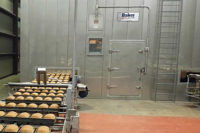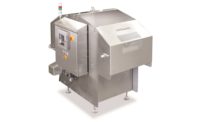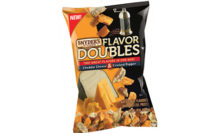Food manufacturers launch thousands of new products each year in response to consumer demand and trends. For bakers and snack producers, adding new stock-keeping units to their inventory can mean adding entire production lines or updating key equipment, like proofers, ovens and fryers, to get more out of existing lines. Whichever option they ultimately choose, today’s bakers and snack producers will find plenty of these industry “workhorses” to meet their specific needs, as well as address energy and sanitation concerns, thanks to new and updated models available from leading baking equipment manufacturers.
“Proofing is largely hidden from view, but industrial bakers know how critical it is, since proofing takes about 40 minutes, whereas frying takes only two minutes or so,” says Mike Baxter, product information and marketing specialist, Belshaw Adamatic Bakery Group. The Auburn, Wash., company designs and manufactures donut-production equipment for retail and wholesale operators as well as divider/rounders and full roll lines for wholesale bakeries in the U.S. Adamatic also partners with Glimek Baking Systems to provide full-size bread lines.
The company continues to improve its High Volume proofer, which, like all Belshaw Adamatic proofers, is designed exclusively for donut production. Recent enhancements include a touchscreen controller that sets temperature accurately up to 120 deg. F and humidity from 35-85%, with closer tolerances than previously possible and using steam-heat exchangers.
Baxter says the company is also focusing on labor-saving conveniences: A product tracker that monitors the progress of donuts inside the proofer; automatic oilers; remote grease injectors for out-of-reach locations; and special modes for quickly exhausting humidity and temperature.
To address food producers’ food safety and sanitation concerns, Belshaw Adamatic constructs its equipment to Baking Industry Sanitation Standards Committee (BISSC) standards. “Our first priority is always responding to concerns from our customers,” says Baxter. “Whatever they are spending time and resources on is what we look at first for improvements. These can be made quite quickly by our engineering and manufacturing teams, which are both firmly based in the USA.”
Ovens for all
Koenig Bakery Systems, Ashland, Va., will be releasing a new version of one of its well-established convection ovens this fall. The PU Integral oven, best known for its small footprint in comparison to other industrial ovens, has been “totally remodeled,” says general manager Rich Breeswine. “Each and every detail and part has been checked, redesigned and improved.”
The main feature of the new model, which can be used to produce all types of baked goods at baking temperatures of up to 540 deg. F, part-baked or ready-baked, is separate and independent baking zones. The zones are sealed from each other for controlled temperature, humidity and air volume. Additionally, the oven is equipped with a separate steaming zone preceding the baking zones. “In other words, the new PU Integral oven works like several single ovens, which allows [operators] to follow precise baking curves that grant controlled and independent parameters in each step,” Breeswine explains.
Furthermore, every mechanical movement of the new oven is now servo-driven, allowing for fast and well-controlled steps and a wide window of possible baking times. It also uses Thermo Oil as a heating medium for its heat exchangers. “Central Thermo Oil heating systems are superior in efficiency to any other type of heat generation,” Breeswine says.
Amanda Hicks, co-CEO of Auto-Bake, says the Sydney-based company has a policy of “continuous improvement, so every system supplied demonstrates new capabilities. In addition, all its Serpentine systems are custom-designed, so they reflect the unique needs of industrial clients internationally.
“In practice, this means a system is configured to match output requirements in baking, cooling, freezing and/or proofing,” says Hicks. “It also can integrate washing and drying systems and robotic product transfer direct into final packaging.”
Auto-Bake’s Serpentine ovens have a wide range of thermal options, from radiant to direct-fired convection, and are available in widths and sizes to suit most spaces. “By having a wide range of options, Auto-Bake ovens cover the gamut of proofed products, sweet goods and savory items,” Hicks adds.
When it comes to energy consumption, Hicks says Auto-Bake offers individual energy monitoring to assist clients in tracking their energy use and reducing unnecessary power consumption costs. “Auto-Bake is proudly the winner of a B.E.S.T. in Baking award in 2013 due to this focus on energy reduction,” she adds (see SF&WB’s B.E.S.T. in Baking supplement, August 2013, and www.snackandbakery.com).
Auto-Bake is in constant communication with clients, building and developing technology in response to their needs. “Initially, our research will be undertaken by computer modeling and then, when perfected, to prototypes and ultimately in-field testing,” Hicks explains. “To assist our clients, we have two industrial systems at our test facility in Chicago, where we can replicate their product from their legacy systems and confirm baking profiles, output rates, etc. This facility is operated by Auto-Bake America, a jointly operated company of both Auto-Bake Australia and Dunbar Systems Inc., Lemont, Ill. Dunbar’s dedicated professionals work with bakers to determine the exact oven need per a product’s specifications.”
Reading Bakery Systems, Robesonia, Pa., designs and manufactures ovens used by bakers to produce cookies, crackers, sheeted snacks, extruded snacks and pretzels. While the company makes improvements to its ovens based on industry needs, some needs are common to the company’s entire oven range, says Shawn Moye, executive director of sales.
Therefore, Reading offers multiple means of delivering radiant heat to products in its snack ovens (direct gas-fired burners, direct gas-fired radiant panel burners, patented SMART Zone radiant tubes and electrical radiant elements). It pre-assembles oven modules at its factory to control manufacturing quality, reduce installation time and ensure performance as designed. It partially constructs and ships oven modules for installation in difficult access points in a bakery. Scorpion data-logging equipment records baking conditions and recommends improvements, while heat exchangers recover exhaust heat to preheat combustion makeup air in convection oven zones.
The latter is just one of several ways in which Reading’s bakery systems address bakers’ energy concerns. Others include using convection air where appropriate in the baking process, using fuel flow meters to record fuel usage and identify opportunities for improvement, using oven belts with lower mass densities, minimizing the exposure of the oven belt outside of the oven chamber and offering downtime software that reduces oven temperature when no product is being processed.
Reading also develops new systems and enhances existing products at its Science and Innovation Center in Sinking Spring, Pa. “Our wide range of research requires our baking systems to have the ability to apply multiple types of thermal characteristics to very different products,” Moye explains. “It is through the use of these heating attributes that we find the precise amount of each baking variable that is right for each product.”
The fryers club
In addition to updating its High Volume proofer, Belshaw Adamatic partnered with Chicago-based JBT FoodTech in 2012-2013 to produce a new, high-volume industrial donut fryer that combines JBT Foodtech’s THERMoFIN clean-frying technologies with Belshaw Adamatic’s donut conveyor. The new fryer is available in 19- to 40-ft. lengths and with capacity from 10,000 to more than 20,000 donuts per hour (more for mini donuts). Special features include THERMoFIN gentle heat transfer, fast shortening turnover, low frying volume and continuous shortening filtration, when required.
According to Baxter, the fryer offers several advantages: Cleaner oil; longer lasting oil; a better fried product; and lower energy consumption. And unlike its proofers, the JBT Foodtech TTF-IV fryer on which the company’s donut fryer is based has logged “millions of frying hours on a very wide variety of foods,” he adds.
Hayward, Calif.-based Heat and Control Inc. constantly improves the designs of its fryers for increased capacity, control, and efficiency, says Don Giles, director of sales for processing systems. The company offers fryers for all types of chips, tostadas, taco shells, nuts, pellets, extruded snacks, French fries, toaster pastries, donuts and prepared foods.
Among the company’s newest developments are the Unitized Vacuum Fryer, a high-capacity potato chip batch fryer and an economical potato chip batch fryer.
The multitasking Unitized Vacuum Fryer produces chips from potatoes, yams, apples, taro root and other products. The unit operates at 10% or less of normal atmospheric pressure, so it boils off product moisture at a lower temperature than traditional fryers and allows frying of high-sugar products without browning. It also controls acrylamide formation because the oil temperature can be kept below 248 deg. F, the point at which acrylamide forms.
The Unitized Vacuum Fryer is similar to a traditional externally heated continuous fryer, the company reports. It requires no external vacuum enclosure, enabling operators to save floorspace and not have to move fryer for cleaning and maintenance. Like other Heat and Control fryers, the Unitized Vacuum Fryer includes a clean-in-place system, continuous oil filter, automatic oil level control and an Oil Mist Eliminator in the exhaust stack.
Heat and Control’s new MasterTherm Kettle Fryer (MTKF) can produce 500 finished lb. of almost any style of batch-fried potato chips per hour. Cooking oil is heated gently and uniformly throughout the fryer by a thermal fluid heat exchanger immersed in the oil. Generous spacing between the heating tubes eliminates areas where fines can accumulate and facilitates cleaning. A full-length hood covers the kettle for safety and additional benefits, including retaining heat for high energy efficiency, steam-blanketing the oil to purge oxygen, prolong oil life and reduce exhaust volume.
Other features include a clean-in-place system; a continuous fines-removal system; an oil/mist eliminator that removes oil droplets from exhaust emissions; a screw-jack hoist system that raises the hood and heat exchanger for fryer access; a Chip-Stirr paddle system; and a programmable logic control (PLC) that maintains a consistent temperature profile from batch to batch and that stores multiple product profiles for quick changeovers and repeatable product quality.
According to Giles, Heat and Control offers many of the features of its high-end batch fryers in the Mastermatic Longitudinal Direct Kettle Fryer (LDKF) line, a space-saving economy model that produces 200 or 300 finished lb. per hour of uniform potato chips. The LDKF also has a versatile and responsive temperature profile, PLC controls, a Chip-Stirr system, automatic oil-level control and a full-coverage hood.
Heat and Control developments are driven by its own research and development to improve production efficiency, sustainability and cost savings for the company’s customers, Giles says. “Some are initiated by requests from the industry,” he adds. “The LDKF batch fryer, for example, was developed after one of our customers approached us about increasing production capacity without expanding their plant, which was also a major tourist attraction. We designed the LDKF to fit their very limited floor space, boost output and still offer the control to duplicate their well-known product.”
Heat and Control systems are designed for thorough sanitation. “In our externally heated fryers, cleaning solution circulates through the same route as cooking oil to completely sanitize all fryer system components and product contact areas,” Giles explains. “Our experience in U.S. Department of Agriculture sanitary cooking and packaging of meat and poultry products has promoted development of spiral and impingement ovens that cook uniformly to assure destruction of harmful pathogens without overcooking, and are thoroughly cleanable, eliminating inaccessible areas where pathogens can develop. And, of course, our Inspection Systems division provides the latest technology in x-ray inspection and metal detection from Ishida and CEIA.”
Whether they’re looking to add a new SKU to their offerings, increase overall output, reduce energy consumption or address another manufacturing concern, bakers and snack producers will find a variety of new and redesigned proofers, ovens and fryers to meet their needs.















